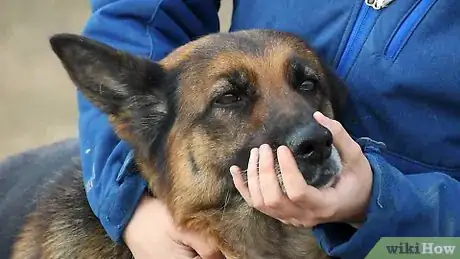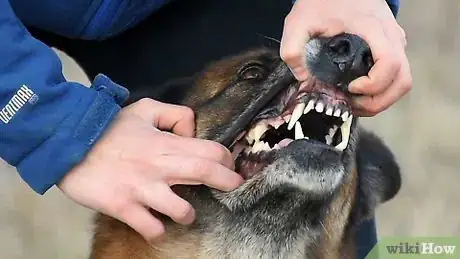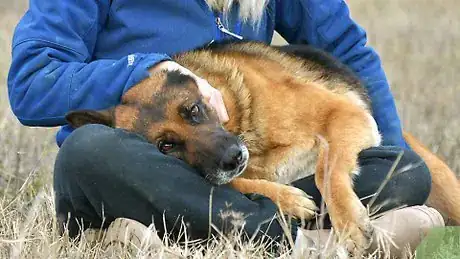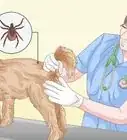This article was co-authored by Beverly Ulbrich. Beverly Ulbrich is a Dog Behaviorist and Trainer and the Founder of The Pooch Coach, a private dog training business based in the San Francisco Bay Area. She is a Certified CGC (Canine Good Citizen) Evaluator by the American Kennel Club and has served on the Board of Directors for the American Humane Association and Rocket Dog Rescue. She has been voted the best private dog trainer in the San Francisco Bay Area 4 times by SF Chronicle and by Bay Woof, and she has won 4 "Top Dog Blog" awards. She has also been featured on TV as a dog behavior expert. Beverly has over 18 years of dog behavior training experience and specializes in dog aggression and anxiety training. She has a Master of Business Administration from Santa Clara University and a BS from Rutgers University.
wikiHow marks an article as reader-approved once it receives enough positive feedback. This article received 20 testimonials and 93% of readers who voted found it helpful, earning it our reader-approved status.
This article has been viewed 578,612 times.
Knowing whether your dog has a fever gives you the option to start treatment early and prevent her condition from getting worse. Although the only way to accurately know if your dog has a fever is by using a rectal thermometer, knowing how to feel a dog’s temperature quickly when you do not have a thermometer can make a big difference.
Steps
Assessing Your Dog's Temperature
-
1Feel your dog’s ears and paws. A dog with fever usually has very hot ears and paws. You can gauge his temperature by using sensitive body parts like your cheeks and the back of your hands over his ears and paws. Are his warmer than yours? Healthy dogs only run slightly higher in temperature than humans.
- A dog's ears and paws have a lot of blood vessels. When he has a fever, these areas get hot because of the migration of immune cells from the blood into the areas of the body where an infection is taking place. The increase in the circulating immune cells in the blood can manifest as heat in the blood vessels.
- It is unusual for the left and right ear to be different temperatures. If one ear is warmer than the other, this is usually a sign of a localized ear infection, rather than a generalized fever.
- Try putting your thumb right outside the entrance of your dog's ear to see if it feels hot.[1]
-
2Feel your dog's nose. If your dog has a hot nose lined with greenish or yellowish nasal discharge, it's likely he has a fever and an infection.[2] [3] This could mean that your dog is fighting off a respiratory infection, though this may be evident only in more serious cases. Certain diseases like distemper and kennel cough have these clinical signs, too. Therefore it is incredibly important that you quickly bring your dog to the vet if you see greenish or yellowish nasal discharges.
- A normal dog can have a fluctuating temperature and level of wetness – it's a myth that dog noses are always cold and wet. In fact, the nose often becomes dry from common situations, such as lying in the sun, sleeping near the radiator, exercising, or when the dog is dehydrated. What does your dog's nose normally feel like? Has he done any of these things recently to account for a dry, hot nose?
Advertisement -
3Feel your dog’s armpits and groin area. These areas are usually swollen and hot when your dog has an infection and fever. You can use the back of your hands to feel for heat in the lymph nodes in the armpits and groin area. However, make sure your own hands are at room temperature, not chilled or hot, as they provide your reference point.
- Lymph nodes contain immune cells that fight bacteria and viruses. They filter the blood against these infectious organisms, and when there is an infection, the lymph nodes serve as a defense area. This area then becomes filled with immune cells that secrete different substances that trigger the brain to cause fever. These areas become swollen and hot because they become inflamed as a result of the different immune reactions going on simultaneously.
- Because the armpit and groin areas of the dog have a lot of exposed skin with very little fur, feeling for heat in these areas can be done easily.
-
4Examine his gums. Your dog's gums may feel warm and dry if he has a fever. Another important sign to watch for here is his gums appearing redder than usual, especially a bright brick red. This can be a sign of high fever, or even septicemia.
- In a dog without dental disease, the gums should be moist, shiny, and a similar pink color to our own gums. Lift up the dog’s lip behind the upper canine tooth, and place the tip of your forefinger against the gum to assess temperature and moistness. Is the color, heat, and moistness similar to yours? If not, infection may be present.
-
5Check for signs of low temperature. An unwell dog, or one in shock, may have a low body temperature. In addition to having cold extremities, the dog may show physiological temperature adaptations such as shaking or getting goosebumps. A dog with a dangerously low temperature will also be very subdued, and possibly collapsed. In this case, seek out your vet immediately.
- Be aware that not all shaking dogs are cold; this can also be a response to stress, anxiety or pain. If you know of no reason for your dog to be acting like this, contact your vet as soon as possible.
Assessing Your Dog's Appearance
-
1Look for the other signs of fever. Apart from physical temperature, one of the first things you can do is to observe your dog for other physical signs of fever. It's important to be alert for changes in normal behavior from having difficulty defecating, to coughing or sneezing, since this may provide vital information as to the seat of infection.[4] Possible symptoms include:[5]
- Poor appetite
- Lethargy, sluggishness or inactivity
- Weakness
- Vomiting
- Diarrhea
- Sleeping all day
- Withdrawing away from other dogs
-
2Observe your dog's appearance and behavior. When a dog runs a significant fever, from a few feet away and without touching him, you can feel heat radiating from his body. There will be a handful of other visible symptoms you can look for, too:
- He is likely to be panting heavily for prolonged periods of time, and his breath will feel hot against your cheek.[6]
- He may be thirsty and drink more water than usual, because he loses fluid as he pants.
- A fever can make joints feel achy and sore. In the dog this manifests itself as a reluctance to exercise, stiffness on rising and a stilted gait or even lameness.
- A dog with a fever will be withdrawn, quiet and lethargic.[7] He may become uncharacteristically aggressive when touched, because he feels uncomfortable and irritable.
- He is less likely to groom and his coat will appear unkempt and "starry," or dull and dry.
-
3Stroke, pet, and engage your dog in play. Try to remember the feel of your dog’s body when he is not sick. Are his eyes dull? His coat less silky? Is he less rambunctious and eager than usual? Changes in these physical and behavioral characteristics may be a sign of illness.
-
4If he seems well, assess him again in an hour. If the dog is behaving naturally, is hot but seems otherwise well, let him rest in a cool place for an hour and then re-check his temperature again to see if the signs you did detect have normalized. Since a fever is a normal immune response, it may just be something you have to wait out if it's not serious.
- Remember, if the temperature of the dog’s extremities is raised and he is behaving abnormally, this is more likely to be significant than for a warm dog that appears otherwise well. It's infection you need to be worried about, not fever.
Understanding Fever in Dogs
-
1Know that fever is a normal immune response. In most situations, fever is nothing to worry about. It's a good indicator that the body is fighting back an infection or is undergoing repairs. In some situations, however, fever can be the sign of a bacterial infection. If your dog is displaying any abnormal symptoms, contact your vet immediately.
- When bacterial infections with gram negative bacteria are present, they release toxins from their cell walls that act as signals to the brain to cause fever. In these cases severe bacterial infection can lead to even more severe fever with a very high temperature.[8] This extreme temperature, instead of helping the animal can lead to damages to sensitive organs, like the testicles and the brain. When this happens, convulsions and coma, and sometimes sterility, can result. Thus it is very important that a fever be detected earlier, and a prompt veterinary therapy be given to prevent these unwanted effects.
-
2Call the vet. When in doubt, contact your vet for a professional opinion. In addition to seeking medical treatment if abnormal symptoms are present, it's a good idea to take this fever seriously if it lasts for more than 24 hours, too. Your vet can prescribe an anti-pyretic (anti-fever) medication to bring his temperature down almost immediately.
-
3Consider other related physical ailments. If your dog's fever is related to another, often more serious, condition, you'll notice another set of symptoms entirely. It could be a more serious respiratory or gastro-intestinal infection. Be on the lookout for the following:
- If he has a respiratory infection he may cough, sneeze, and have a runny nose or streaming eyes. This will likely impede his normally rambunctious behavior and sleep patterns, too.
- If he has gastro-intestinal infection or inflammation, then he may be anorexic, vomit or have diarrhea. If you suspect he has a gastro-intestinal disturbance, follow him outside when he toilets so that you can see what he passes. Does he have diarrhea? Is there blood in his urine?
- If you notice anything abnormal related to either condition, consult your vet immediately. There is likely an infection present; fever is just one of many symptoms present that need to be addressed.
Expert Q&A
Did you know you can get expert answers for this article?
Unlock expert answers by supporting wikiHow
-
QuestionIs my dog sick or just tired?
 Beverly UlbrichBeverly Ulbrich is a Dog Behaviorist and Trainer and the Founder of The Pooch Coach, a private dog training business based in the San Francisco Bay Area. She is a Certified CGC (Canine Good Citizen) Evaluator by the American Kennel Club and has served on the Board of Directors for the American Humane Association and Rocket Dog Rescue. She has been voted the best private dog trainer in the San Francisco Bay Area 4 times by SF Chronicle and by Bay Woof, and she has won 4 "Top Dog Blog" awards. She has also been featured on TV as a dog behavior expert. Beverly has over 18 years of dog behavior training experience and specializes in dog aggression and anxiety training. She has a Master of Business Administration from Santa Clara University and a BS from Rutgers University.
Beverly UlbrichBeverly Ulbrich is a Dog Behaviorist and Trainer and the Founder of The Pooch Coach, a private dog training business based in the San Francisco Bay Area. She is a Certified CGC (Canine Good Citizen) Evaluator by the American Kennel Club and has served on the Board of Directors for the American Humane Association and Rocket Dog Rescue. She has been voted the best private dog trainer in the San Francisco Bay Area 4 times by SF Chronicle and by Bay Woof, and she has won 4 "Top Dog Blog" awards. She has also been featured on TV as a dog behavior expert. Beverly has over 18 years of dog behavior training experience and specializes in dog aggression and anxiety training. She has a Master of Business Administration from Santa Clara University and a BS from Rutgers University.
Dog Behaviorist & Trainer
-
QuestionHow can you tell if a dog has a fever?
 Beverly UlbrichBeverly Ulbrich is a Dog Behaviorist and Trainer and the Founder of The Pooch Coach, a private dog training business based in the San Francisco Bay Area. She is a Certified CGC (Canine Good Citizen) Evaluator by the American Kennel Club and has served on the Board of Directors for the American Humane Association and Rocket Dog Rescue. She has been voted the best private dog trainer in the San Francisco Bay Area 4 times by SF Chronicle and by Bay Woof, and she has won 4 "Top Dog Blog" awards. She has also been featured on TV as a dog behavior expert. Beverly has over 18 years of dog behavior training experience and specializes in dog aggression and anxiety training. She has a Master of Business Administration from Santa Clara University and a BS from Rutgers University.
Beverly UlbrichBeverly Ulbrich is a Dog Behaviorist and Trainer and the Founder of The Pooch Coach, a private dog training business based in the San Francisco Bay Area. She is a Certified CGC (Canine Good Citizen) Evaluator by the American Kennel Club and has served on the Board of Directors for the American Humane Association and Rocket Dog Rescue. She has been voted the best private dog trainer in the San Francisco Bay Area 4 times by SF Chronicle and by Bay Woof, and she has won 4 "Top Dog Blog" awards. She has also been featured on TV as a dog behavior expert. Beverly has over 18 years of dog behavior training experience and specializes in dog aggression and anxiety training. She has a Master of Business Administration from Santa Clara University and a BS from Rutgers University.
Dog Behaviorist & Trainer If you're worried that your dog may have a fever, then knowing their ear temperature really helps. I recommend putting your thumb inside the dog's ear, specifically the entrance of their ear. If you know what their normal temperature is and how it feels, then when it gets hotter, you'll feel it and know something is wrong.
If you're worried that your dog may have a fever, then knowing their ear temperature really helps. I recommend putting your thumb inside the dog's ear, specifically the entrance of their ear. If you know what their normal temperature is and how it feels, then when it gets hotter, you'll feel it and know something is wrong. -
QuestionMy dog's stomach feels hot at night. Does this mean he is sick?
 Pippa Elliott, MRCVSDr. Elliott, BVMS, MRCVS is a veterinarian with over 30 years of experience in veterinary surgery and companion animal practice. She graduated from the University of Glasgow in 1987 with a degree in veterinary medicine and surgery. She has worked at the same animal clinic in her hometown for over 20 years.
Pippa Elliott, MRCVSDr. Elliott, BVMS, MRCVS is a veterinarian with over 30 years of experience in veterinary surgery and companion animal practice. She graduated from the University of Glasgow in 1987 with a degree in veterinary medicine and surgery. She has worked at the same animal clinic in her hometown for over 20 years.
Veterinarian Not necessarily. If your dog gets warm during the night, he will lose eat best from the parts of his body that have the thinnest fur, ie his belly. When you place a hand on his belly it will therefore feel warm to the touch, but this is heat being dissipated rather than his gut generating heat because he is unwell. Watch for signs such as lack of appetite, vomiting, or diarrhea, which would indicate he is poorly.
Not necessarily. If your dog gets warm during the night, he will lose eat best from the parts of his body that have the thinnest fur, ie his belly. When you place a hand on his belly it will therefore feel warm to the touch, but this is heat being dissipated rather than his gut generating heat because he is unwell. Watch for signs such as lack of appetite, vomiting, or diarrhea, which would indicate he is poorly.
References
- ↑ Beverly Ulbrich. Dog Behaviorist & Trainer. Expert Interview. 30 January 2020.
- ↑ Beverly Ulbrich. Dog Behaviorist & Trainer. Expert Interview. 30 January 2020.
- ↑ http://www.hillspet.com/dog-care/facts-dogs-dry-nose-mature-adult.html
- ↑ 4.04.1A Study of the Mechanism and Treatment of Experimental Heat Pyrexia. Daily, William, Harrison, Tinsley. American Journal of Medical Sciences. Jan48, Vol 215, Issue I, p42-55
- ↑ http://pets.webmd.com/dogs/high-fever-in-dogs
- ↑ Beverly Ulbrich. Dog Behaviorist & Trainer. Expert Interview. 30 January 2020.
- ↑ Beverly Ulbrich. Dog Behaviorist & Trainer. Expert Interview. 30 January 2020.
- ↑ General Veterinary Pathology (1984) by R.G. Thomson: Department of Veterinary Clinical Pathology Western College of Veterinary Medicine, University of Saskatchewan. W.B. Saunders Company 1984. p. 249
About This Article
Although taking a dog's temperature does require a thermometer, you can look for signs that indicate your dog may have a fever or infection. For example, use the back of your hands to check if its ears, paws, armpits, or groin area feel hot or swollen. Next, look at your dog’s nose to see if it has a green or yellow discharge. You can also examine its gums to see if they feel warm or dry, or look redder than usual. If your dog shows any of these signs, call your vet to see if you should bring your dog in for treatment. For more tips from our Veterinary co-author, like how to recognize the behavioral signs of a high or low temperature, read on!






































































